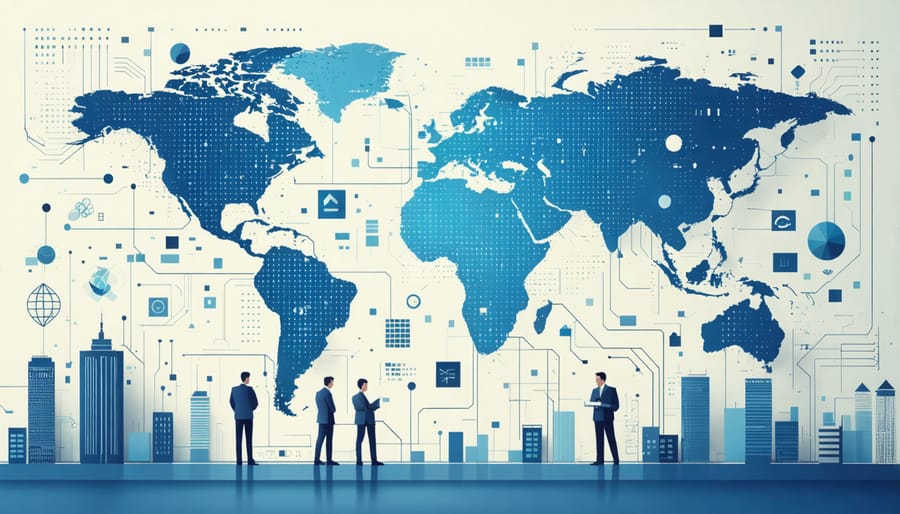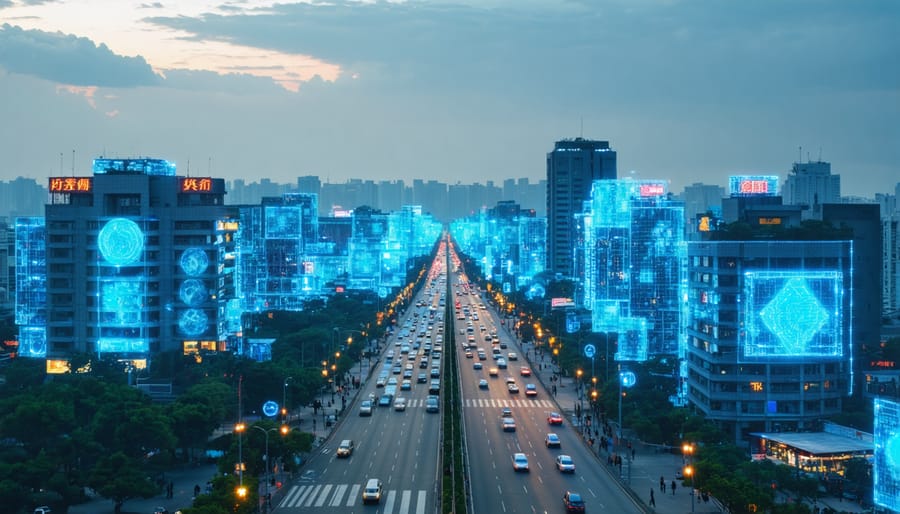When you think of artificial intelligence innovation, Silicon Valley probably comes to mind first. But that narrow view misses the extraordinary AI revolution happening across Asia, the Middle East, Africa, and Latin America—regions now driving breakthroughs that rival or even surpass Western developments.
China deploys AI-powered facial recognition systems across 200 million surveillance cameras, while Chinese tech giants like Baidu and Alibaba pioneer everything from autonomous vehicles to natural language processing in Mandarin. India’s AI startups are transforming agriculture with predictive models that help millions of small farmers optimize crop yields. Meanwhile, Singapore has positioned itself as Southeast Asia’s AI hub, investing billions in research and attracting top global talent.
The shift in global AI leadership extends beyond these major players. Israel’s military-tech ecosystem produces cutting-edge computer vision and cybersecurity AI. South Korea’s Samsung and LG are embedding AI into consumer electronics at unprecedented scale. Even smaller nations like Estonia are digitizing entire governments with AI-driven services, while the UAE invests heavily in AI to diversify its economy.
Understanding these non-Western contributions isn’t just about fairness—it’s essential for grasping where AI is actually heading. Different cultural contexts produce different innovations: China focuses on practical applications at massive scale, India emphasizes affordable solutions for resource-constrained environments, and Middle Eastern nations explore AI governance frameworks that balance innovation with social values. This diversity of approaches is reshaping what AI can do and who it serves.
Why the Western-Centric AI Narrative Is Incomplete
When you think of artificial intelligence, Silicon Valley giants like Google and OpenAI probably come to mind first. This isn’t accidental—it’s the result of decades of Western-dominated tech media coverage and venture capital narratives that have shaped how we perceive innovation. But this story is incomplete, and relying on it means missing half the picture of how AI is actually evolving worldwide.
The reality is that AI development has always been a global endeavor. While English-language media spotlights achievements from California and London, transformative work happens simultaneously across Asia, the Middle East, Africa, and Latin America. These regions aren’t just adopting Western technology—they’re creating original solutions to unique challenges that Western developers often overlook.
Consider China’s development of AI-powered mobile payment systems that now serve over a billion users, or Estonia’s AI-driven government services that have revolutionized civic engagement. These weren’t adaptations of Western models; they were breakthrough innovations born from distinct cultural needs and technological approaches.
Why does geographic diversity matter for AI’s future? Because homogeneous development creates blind spots. When AI systems are designed primarily by teams in similar environments, they reflect limited perspectives on language, culture, and problem-solving. An AI trained predominantly on Western data struggles with non-Western languages, contexts, and applications.
The smartphone revolution offers a parallel lesson. While Apple and Samsung dominated headlines, companies like Xiaomi and Samsung transformed how billions of people access technology by addressing price points and features that Western manufacturers initially ignored.
Today, as AI becomes embedded in everything from healthcare to agriculture, we need solutions shaped by diverse geographic realities. A farmer in India faces different challenges than one in Iowa, and AI applications must reflect that. Understanding which countries are advancing AI—and how—isn’t just about fairness; it’s about building more effective, inclusive technology for everyone.

China: Racing Past Expectations
Real-World Applications Changing Daily Life
Beyond research labs, AI is transforming everyday life across the globe through practical applications that millions now depend on. In Singapore, the Smart Nation initiative deploys AI-powered sensors throughout the city to manage traffic flow, predict maintenance needs, and optimize energy consumption in public housing—reducing electricity costs by up to 15% for residents.
China’s Ping An Good Doctor uses AI diagnostics to serve over 400 million registered users, providing preliminary health assessments through smartphone apps. The system analyzes symptoms and medical history to recommend treatments or specialist consultations, making quality healthcare more accessible in rural areas where doctors are scarce.
Meanwhile, India’s agricultural sector has embraced AI to support its 100 million farmers. The government-backed Kisan Suvidha platform combines satellite imagery with machine learning to predict crop yields, detect pest infestations early, and provide personalized farming advice in local languages. This technology helps farmers increase productivity while reducing water usage and pesticide application.
These aren’t experimental pilots—they’re scaled solutions serving real populations right now, demonstrating how different countries adapt AI to address their unique challenges and priorities.

Research Leadership in Key Areas
China has emerged as a formidable force in AI research, producing more academic papers on artificial intelligence than any other nation. In 2021 alone, Chinese researchers published over 50,000 AI-related papers—significantly outpacing the United States. This research dominance isn’t just about quantity; China leads in high-impact citations in several specialized areas.
The country’s strength particularly shines in computer vision and speech recognition. Chinese tech giants like Baidu, Alibaba, and Tencent have developed facial recognition systems that can identify individuals in crowds of thousands within seconds. These real-world applications power everything from mobile payment authentication to smart city surveillance systems across China.
In patent filings, China has taken the global lead, accounting for nearly 75% of all AI-related patents filed worldwide between 2013 and 2023. While some question the quality versus quantity debate, many Chinese patents focus on practical applications rather than theoretical foundations—reflecting the country’s emphasis on deploying AI solutions that solve immediate, real-world problems. This approach has accelerated innovation in areas like natural language processing for Mandarin, creating technology specifically designed for the world’s most spoken language.
India: The AI Talent Factory
Solving Local Problems with AI
India’s AI innovators are tackling challenges uniquely relevant to their communities, creating solutions that make a real difference in people’s daily lives. Take agriculture, for instance—over 60% of India’s population depends on farming. AI-powered apps now help farmers identify crop diseases simply by photographing affected plants with their smartphones. These tools provide instant diagnoses and treatment recommendations in local languages, preventing crop losses that could devastate families.
Language barriers have long hindered digital access across India’s diverse regions. Enter multilingual chatbots that understand and respond in Hindi, Tamil, Bengali, and dozens of other languages. Banks, government services, and businesses use these AI assistants to serve populations previously excluded by English-only interfaces.
Perhaps most impactful is healthcare innovation. Indian startups have developed affordable AI diagnostic tools costing a fraction of traditional equipment. Portable devices using machine learning can detect tuberculosis, analyze X-rays, and screen for diabetic retinopathy—bringing medical expertise to remote villages where doctors are scarce.
These aren’t just technological achievements; they’re examples of how AI can address pressing local needs. By focusing on accessibility and affordability, Indian developers prove that meaningful AI innovation doesn’t require Silicon Valley resources—just deep understanding of community challenges.

South Korea and Japan: Robotics and Integration Masters
South Korea and Japan stand at the forefront of robotics and AI integration, transforming how humans interact with intelligent machines in everyday life. These neighboring nations have channeled their technological expertise into creating AI systems that don’t just compute—they physically interact with the world around us.
Japan’s approach to AI reflects its unique demographic challenges. With a rapidly aging population, the country has pioneered robots designed specifically for elderly care. SoftBank’s Pepper robot greets visitors in hospitals and retail stores, while PARO, a therapeutic seal robot, provides companionship to seniors with dementia. These aren’t just mechanical assistants—they’re equipped with AI that learns individual preferences and responds to emotional cues, making interactions feel surprisingly natural.
In manufacturing, both countries have mastered automation at unprecedented scales. Japanese automotive giants use AI-powered robots that can adapt to new tasks through machine learning, rather than requiring complete reprogramming. This flexibility has revolutionized production lines, making them more efficient and responsive to changing demands.
Sony’s AI research division pushes boundaries in computer vision and sensory processing, developing technologies that help robots navigate complex environments. Their work on predictive algorithms enables robots to anticipate human movements, crucial for safe human-robot collaboration in factories and homes.
Samsung, South Korea’s tech powerhouse, has evolved Bixby from a simple voice assistant into an AI platform that learns user routines across multiple devices. Their AI chips now power everything from smartphones to smart refrigerators, creating interconnected ecosystems that adapt to household patterns.
These innovations demonstrate how South Korea and Japan are shaping a future where AI seamlessly blends into physical spaces, making technology more accessible and genuinely helpful in solving real-world challenges.

The Middle East and Africa: Emerging AI Frontiers
Israel’s AI Security and Agriculture Innovations
Israel has emerged as a global powerhouse in specialized AI applications, particularly where security meets innovation. The country’s mandatory military service has created an unusual pipeline—young tech talent from elite intelligence units like Unit 8200 transition into civilian startups, bringing expertise in cybersecurity AI and real-time threat detection systems that now protect networks worldwide.
In computer vision, Israeli companies have developed sophisticated facial recognition and autonomous vehicle technologies. These systems excel at processing visual data in challenging conditions, from low-light surveillance to navigation in unpredictable environments. The practical applications span airport security, medical imaging analysis, and manufacturing quality control.
Perhaps most impressive is Israel’s precision agriculture revolution. Facing water scarcity and limited arable land, Israeli engineers developed AI-powered drip irrigation systems and crop monitoring drones that optimize every drop of water and fertilizer. These technologies analyze soil conditions, weather patterns, and plant health in real-time, increasing yields while reducing resource consumption. Today, these innovations help farmers across Africa, Asia, and Latin America tackle similar environmental challenges.
Africa’s Mobile-First AI Solutions
Africa’s unique technological landscape has sparked remarkably innovative AI solutions. With mobile phone penetration far exceeding traditional internet infrastructure, African developers are building AI applications that thrive in low-bandwidth environments and work seamlessly on basic smartphones.
In Kenya, startups like FarmDrive use AI to assess creditworthiness for smallholder farmers through mobile data, providing loans to those traditionally excluded from banking systems. Nigeria’s Ubenwa has developed an AI that detects birth asphyxia in newborns through cry analysis—functioning entirely offline on mobile devices to serve remote clinics without reliable internet.
South African developers are creating natural language processing models that handle the continent’s linguistic diversity, processing multiple languages including Swahili, Yoruba, and Zulu. These mobile-first solutions demonstrate how constraints can drive innovation, resulting in lightweight AI models that consume minimal data and battery power.
This approach offers valuable lessons for AI development worldwide, proving that effective artificial intelligence doesn’t always require massive computing resources or constant connectivity.
What Non-Western AI Development Teaches Us
Non-Western AI development offers crucial lessons that challenge Silicon Valley’s dominance as the sole blueprint for innovation. These diverse approaches reveal that effective AI isn’t one-size-fits-all—it must reflect the communities it serves.
**Cultural Context Shapes Priorities**
China’s emphasis on AI for social harmony contrasts sharply with Western individualism-focused applications. Their facial recognition systems prioritize collective security over personal privacy—a trade-off that aligns with cultural values dating back centuries. Meanwhile, India’s AI investments concentrate on solving infrastructure challenges like agricultural optimization and multilingual support, directly addressing the needs of a billion-plus population.
**Localized Data Makes Better AI**
Perhaps the most significant lesson: AI trained exclusively on Western data fails globally. When healthcare AI developed in the US was deployed in Africa, it performed poorly because the training data didn’t include diverse skin tones or regional disease patterns. Countries like Kenya and Nigeria are now building datasets reflecting their populations, creating AI that actually works for their citizens. This localization extends beyond healthcare—financial inclusion AI in Southeast Asia accounts for informal economies that Western models ignore entirely.
**Different Ethics Considerations Emerge**
Non-Western perspectives introduce ethical frameworks beyond typical Western concerns. Japanese AI development emphasizes harmony between humans and machines, drawing from Shinto beliefs about consciousness in objects. Middle Eastern nations grapple with balancing AI innovation against religious values, creating unique governance models.
**The Global Implication**
These varied approaches demonstrate that effective global AI development requires collaboration, not domination by any single region. When countries bring their cultural context, local challenges, and unique data to the table, we build AI systems that truly serve humanity’s diversity—not just replicate one culture’s assumptions worldwide.
The world of AI is far richer and more diverse than headlines might suggest. From China’s groundbreaking computer vision systems to Singapore’s smart city innovations, from India’s healthcare AI solutions to the UAE’s ambitious national strategies, meaningful contributions are emerging from every corner of the globe. These aren’t just stories of catching up—they’re examples of leading, innovating, and solving problems in ways that reflect unique cultural contexts and regional needs.
As you continue exploring AI, make it a point to follow developments beyond Silicon Valley. Subscribe to news from countries like South Korea, Brazil, or Israel. Pay attention to research coming out of African and Middle Eastern universities. These diverse perspectives aren’t just adding volume to AI development; they’re fundamentally strengthening the technology itself by bringing different viewpoints, ethical frameworks, and problem-solving approaches to the table.
The future of AI won’t be written by any single country or region—it will be a truly collaborative global story. By understanding and appreciating contributions from around the world, we become better equipped to build AI systems that work for everyone, everywhere. The question isn’t which country will “win” AI, but rather how we’ll work together to ensure this powerful technology benefits all of humanity.

